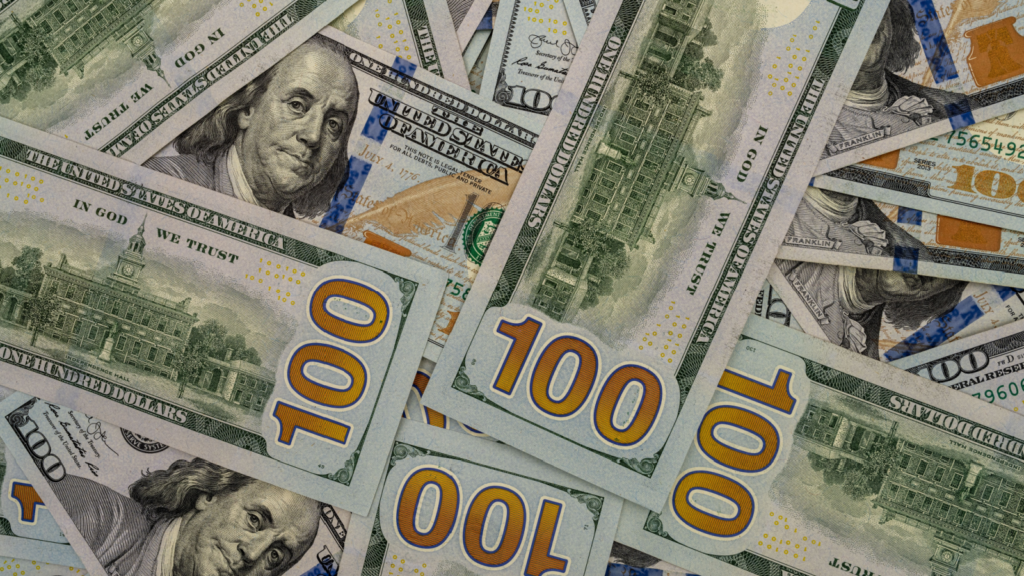Two weeks ago, I wrote how Bitcoin’s (BTC-USD) sudden surge was a positive sign for other risky bets. Bitcoin prices are solely determined by what others will pay, and so rising prices is a clear sign of investor bullishness (i.e., greed).
That’s why the five recommended stocks and cryptos from that issue have done so well. On average, these one-month momentum plays have seen prices rise by 17% since March 4.
- Plug Power (NASDAQ:PLUG): -13%
- SoundHound AI (NASDAQ:SOUN): +52%
- Nvidia (NASDAQ:NVDA): +4%
- Ethereum (ETH-USD): +1%
- Solana (SOL-USD): +41%
- Average: +17%
But there’s also another bubble happening in the market.
And that’s in cash.
As Louis Navellier explains in his latest presentation this week, rising asset prices have created an entire cohort of fearful savers. A record $8.8 trillion now sits in money market fund assets, more than twice as much as in 2018. Gold prices recently hit an all-time high. And despite the market’s recent rise, a full 54% of market participants are still either neutral or bearish on the market, according to the American Association of Individual Investors.
That’s created an incredible divergence between the “haves” and “have-nots” of stock valuations.
On the haves side, we’re seeing incredible surges in assets like SoundHound and Ethereum, where risk-seeking investors have no trouble stomaching even more risk. Crypto has been so hot that I wrote about it a second time last week!
On the other hand, the have-nots have seen their valuations plummet. No fewer than 600 U.S. stocks trade at less than 10 times forward earnings, and these include stalwarts like Verizon (NYSE:VZ) (8.8X), Prudential (NYSE:PRU) (8.2X) and Walgreens Boots Alliance (NASDAQ:WBA) (6.2X). Conservative investors who would have ordinarily bought stocks like these on the dip are sitting on cash instead.
This barbell distribution has created some incredible opportunities in the ignored middle, as our writers at InvestorPlace.com note this week. Hundreds of high-potential stocks remain overlooked by markets. And this week, they pick out four stocks they feel can turn $100,000 into $1 million, given a long enough holding period.
4 Overlooked Stocks to Buy: Li Auto (LI)

I’ve long been a skeptic of the Chinese electric vehicle market. Too many new competitors were vying to become “the next Tesla,” and clearly not all could succeed. I was particularly unconvinced about Nio (NYSE:NIO), a company whose shares have fallen 70% since I panned it in 2020.
However, Omor Ibne Ehsan rightly notes this week at InvestorPlace.com that some winners are finally emerging. And in particular, he picks out Li Auto (NASDAQ:LI) as the right firm to buy:
Li Auto exemplifies the rapid electrification happening across the Chinese auto market. The company has consistently bested expectations, delivering record EV sales month after month. Within China, Li Auto’s growth trajectory is outpacing rivals BYD and Tesla…. Li Auto projects first quarter 2024 deliveries to jump 90-96% over last year.
Ehsan also points out that Li Auto trades at just 18 times forward earnings, making it one of the cheapest high-growth firms on the market. Earnings are expected to surge 50% through 2025 as sales continue to grow. This is vastly different from the eyewatering valuations Nio once traded at.
Most importantly, Li Auto is proving that Chinese carmakers can become as good (or even better) as their American, European Union, Japanese, and Korean counterparts. The Chinese firm is already experimenting with small-scale exports to Europe, and even Mercedes-Benz CEO Ola Kallenius is welcoming the move as a way to force EU carmakers to improve faster.
Though Li Auto still has plenty of challenges ahead, even I’m coming around to the proposal that this Chinese EV startup could beat Tesla (NASDAQ:TSLA) at its own game.
2. UiPath (PATH)

This company is perhaps the most underrated artificial intelligence stock on the market. In 2022, shares tumbled after UiPath (NYSE:PATH) slashed its growth guidance. Corporate belt-tightening was all the rage, and UiPath had unfortunately invested in a sales strategy that relied on channel partners. During bad times, these nonexclusive sales partners avoid selling more complex products, and UiPath’s process automation software took a backseat.
Nevertheless, growth could be finally returning, as Rick Orford writes this week for InvestorPlace.com:
What makes me bullish about PATH is its improving financials. Q3’24 reported a 24% YoY growth for both revenue and ARR. ARR, in particular, reached $1.38 billion. A closer look into its financials indicates a consistent ARR growth, with an estimated 35% CAGR going back to 2022.
Its customer base is also growing, with the number of large customers spending $100k yearly reaching 1,947. Meanwhile, million-dollar customers have grown from 201 to 264 YoY.
The process automation firm has also been refocusing itself on larger enterprise customers, as UiPath CEO Robert Enslin made clear in his Q4 earnings call. Though landing these clients requires more upfront investments in product specialists and sales engineers, it reduces reliance on the less predictable (and less lucrative) midmarket segment.
We’re already seeing the initial signs of success. The New York-based company announced results on March 13 that beat both sales and profit guidance. And maybe best of all, shares still remain widly cheap relative to growth. The stock trades at just 42 times forward earnings, or less than half of what other fast-growing AI companies currently see.
3. Ring Energy (REI)

This Permian Basin oil and gas driller is about as deep value as you can get. Its shares trade at less than 4 times earnings… which comes to 1.6 times cash flow or 0.37 times book value. That makes Ring Energy (NYSEMKT:REI) one of the cheapest energy plays that money can buy.
These low valuations stem from Ring’s strategy of using debt to fund acquisitions. Since 2018, the Midland, Texas, company has raised almost $500 million from creditors to buy competitors and expand organically. In 2023, it spent almost a third of operating income on interest payments alone.
But this debt has funded some magnificent cash-reserve aquisitions, as Faisal Humayun notes in his InvestorPlace piece on seven “zero to hero” stocks.
The Company reported proved reserves of 138.1MMboe with proved developed reserves of 65%. It’s worth noting that the Company’s PV10 (present value of estimated future oil and gas revenues at 10% discount rate) is $2.77 billion. Currently, Ring Energy has a market valuation of $273 million. This is indicative of the level of undervaluation.
Humayun also observes that Ring could quickly deleverage itself if oil prices remain high. The company generates roughly $15 million in free cash flow every quarter at current prices, and a return to 2022-level oil prices could see that figure double to $30 million. Though cash-hoarding investors might have avoided Ring Energy for its high debts, history tells us that these low-cost, cash-generating bets usually pay off in the end.
4. ACM Research (ACMR)

In 2022, Louis Navellier, Eric Fry, and Luke Lango recommended ASML Holding (NASDAQ:ASML) for Power Portfolio 2023, a buy-and-hold portfolio service that takes advantage of long-term holding periods. It wasn’t an immediate success. Shares of the Dutch chip equipment maker would trade sideways for almost a year before surging in October 2023. For those who held on, the rewards have been phenomenal.
That’s often what happens with companies that service the semiconductor industry. You can have months… or even years… where rising secular demand is canceled out by a cyclical slowdown. And when the cycle eventually turns, you end up with two tailwinds instead of just one.
That’s what will likely happen with ACM Research (NASDAQ:ACMR), a leading wafer packaging and cleaning company for the semiconductor industry. Its performance was hampered by the same chipmaking slowdown in 2022-23, and Terel Miles writes this week at InvestorPlace.com that he believes the firm is now set to benefit from the rising demand for generative AI:
ACM Research’s cutting edge technology is pivotal in enhancing the performance and reliability of integrated circuits (ICs)…
One of the key drivers of growth has been the strength of its multi-product portfolio and growing customer base. In FY23, ACM’s revenue increased 43% YOY to $558 million. EPS skyrocketed nearly 100% to $1.16 per share, with operating margin expanding by 200 bps.
Analysts are also becoming increasingly bullish about a new chip manufacturing supercycle. ACM’s 2025 earnings have been revised up a stunning 27% since January, and these revisions are often a sign of further gains to come.
Best of all, ACM Research has been overlooked by investors seeking a more direct investment in AI. Shares of the California-based firm trade at just 18 times forward earnings, roughly half of other semiconductor-related firms like Lam Research (NASDAQ:LRCX). And if sales growth rises at the 25% to 30% that Wall Street analysts expect, ACM’s future intrinsic value could be worth over 10 times its market price today.
The New Cash Bubble
Earlier this month, trading platform Robinhood quietly updated its cash-sweep program. This coming May, the interest earned on any uninvested cash in customer trading accounts would will fall from 1.5% APR to just 0.01%.
The reason is obvious. In 2023, Robinhood’s users added $2.2 billion in uninvested cash. Interest payments on this alone would have widened Robinhood’s loss by almost 10%. Even large banks are feeling the pinch. In the most recent quarter, Bank of America noted that rising deposit costs had shaved off $700 million from its net interest income. Companies are perversely finding ways to make themselves less attractive to depositors.
Louis Navellier believes this change could have a profound impact on those sitting on cash. Because once these conservative investors begin to jump back into the market, history tells us that the money ends up in some extremely unusual places.
That’s why return-seeking investors should consider these under-the-radar stocks that should do well over the longer run. And if you want to find bets that will also do well in the shorter term too, click here to watch Louis’s Emergency Cash Bubble Briefing.
On the date of publication, Thomas Yeung did not have (either directly or indirectly) any positions in the securities mentioned in this article. The opinions expressed in this article are those of the writer, subject to the InvestorPlace.com Publishing Guidelines.
